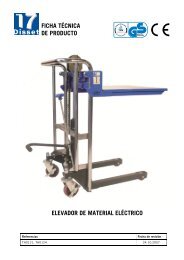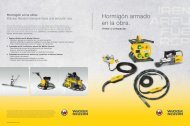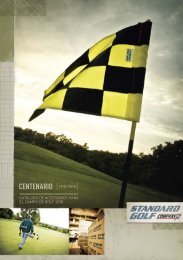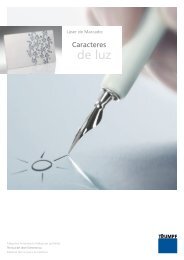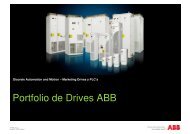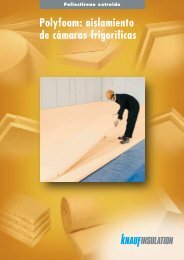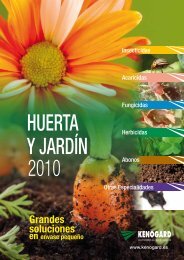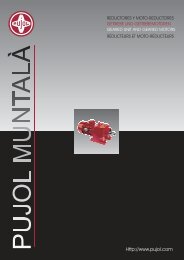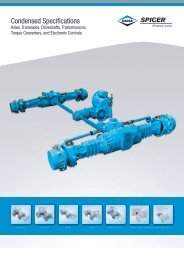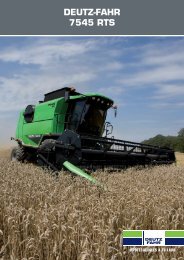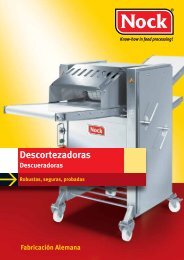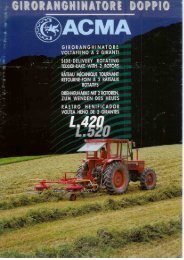2 - Interempresas
2 - Interempresas
2 - Interempresas
Create successful ePaper yourself
Turn your PDF publications into a flip-book with our unique Google optimized e-Paper software.
Mechanical design<br />
Conception mécanique<br />
Mechanische Ausführung<br />
The entire armature is impregnated to<br />
ensure a high degree of heat transfer<br />
and good protection against dust. The<br />
coil ends are TIG-welded to the commutator.<br />
The welding points withstand<br />
overloading and overheating.<br />
Shaft<br />
The standard shaft end is provided<br />
with a key. Shaft extensions and<br />
keyways are according to DIN 8,<br />
part , to VSM 152 , and to IEC<br />
Recommendations 00 2-1 or 00 2-2,<br />
however some shaft extensions do not<br />
have shaft shoulder (see further under<br />
chapter ”Maximum torque for standard<br />
shafts”, page 18.<br />
The armature has a high critical speed<br />
and is resistant to bending to permit<br />
V-belt drive (see further under chapter<br />
“Pulleys”). For drives with rapid and<br />
frequent changes in the direction of<br />
torque, looseness can occur between<br />
shaft, key and coupling. DMI motors<br />
can be ordered with a special shaft<br />
end without key for shrink fit couplings<br />
to avoid this.<br />
The maximum torque Mmax which<br />
can be transmitted by standard shaft<br />
extensions with diameter D are in<br />
accordance with the table “Maximum<br />
torque for standard shafts”, page 18.<br />
With some exceptions standard DMI<br />
can be mounted mechanically in<br />
tandem. When needed, a modified<br />
design for higher torque is available<br />
to allow mounting in tandem e.g. See<br />
notes to table “Maximum torque for<br />
standard shafts”, page 18.<br />
1<br />
Shaft<br />
Arbre<br />
Welle<br />
L’induit tout entier est imprégné, ce<br />
qui assure un transfert thermique<br />
efficace et une bonne protection<br />
contre la poussière. Les extrémités du<br />
bobinage sont soudées au collecteur.<br />
Les points de soudage supportent la<br />
surcharge et la surchauffe.<br />
Arbre<br />
L’extrémité d’arbre standard est munie<br />
d’une clavette. Les bouts d’arbre et les<br />
rainures de clavetage sont conformes<br />
à DIN 8, partie , à VSM 152 et<br />
aux Recommandations 00 2-1 ou<br />
00 2-2 ; cependant, certaines rallonges<br />
d’arbre n’ont pas d’épaulement<br />
d’arbre (voir ci-après au chapitre<br />
”Couple maximum pour arbres standard”,<br />
page 18.<br />
L’induit a une vitesse critique élevée<br />
et sa résistance à la flexion permet<br />
l’emploi d’une transmission par courroie<br />
trapézoïdale (voir plus loin au<br />
chapitre «Poulies»). Pour les transmissions<br />
à changements rapides de direction<br />
du couple, il peut se produire<br />
du jeu entre arbre, clavette et accouplement.<br />
Pour éviter cela, les moteurs<br />
DMI peuvent être commandés avec<br />
un bout d’arbre spécial sans clavette<br />
pour les accouplements à ajustement<br />
à chaud.<br />
Le couple maximum Mmax pouvant<br />
être transmis par des bouts d’arbre<br />
standards de diamètre D est indiqué<br />
dans le tableau « Couple maximum<br />
pour arbres standards », page 18.<br />
A quelques exceptions près, les<br />
moteurs DMI standards peuvent être<br />
montés mécaniquement en tandem.<br />
Si nécessaire, des versions modifiées<br />
à couple plus élevé sont disponibles,<br />
notamment pour permettre le montage<br />
en tandem. Voir notes du tableau<br />
« Couple maximum pour arbres<br />
standards », page 18.<br />
Der gesamte Läufer erhält durch<br />
Imprägnierung ein gutes Wärmeleitvermögen<br />
und wird gleichzeitig staubabweisend.<br />
Die Spulenenden sind am<br />
Kommutator wolframinertverschweißt.<br />
Die Schweißpunkte halten hohe<br />
Überlastungen und Übertemperaturen<br />
stand.<br />
Welle<br />
Das standardmäßige Wellenende ist<br />
Mit einer Paßfeder versehen. Wellenenden<br />
und Paßfedern sind gemäß<br />
DIN 8, Teil , VSM 152 und IEC<br />
Empfehlungen 00 2-1 oder 00 2-2<br />
ausgeführt. Allerdings besitzen einige<br />
Wellenverlängerungen keinen Absatz<br />
(siehe ”Maximales Drehmoment<br />
für Standardwellen”, seite 18 weiter<br />
unten). Der Läufer hat eine hohe<br />
kritische Drehzahl und erlaubt dank<br />
seiner Biegefestigkeit Keilriemenantrieb<br />
(siehe weiteres im Abschnitt<br />
„Riemenantriebe“). Bei Antrieben<br />
mit schnellen und häufigen Änderungen<br />
der Drehmomentrichtung, z.<br />
B. in Umkehrwalzenstraßen, kann<br />
Spiel zwischen Welle, Paßfeder und<br />
Kupplung entstehen. Um dies zu<br />
vermeiden, können DMI-Motoren in<br />
Sonderausführung mit Wellenende<br />
ohne Paßfedernut für Kupplung mit<br />
Schrumpfsitz angeboten werden.<br />
Das höchste Drehmoment Mmax , das<br />
von einem Standardwellenende mit<br />
Durchmesser D übertragen werden<br />
kann, ist aus der Tabelle „Maximales<br />
Drehmoment für Standardwellen”<br />
ersichtlich. (Seite 18)<br />
Standard-DMI können mit wenigen<br />
Ausnahmen mechanisch als Tandem<br />
gekoppelt eingesetzt werden. Auf<br />
Anfrage sind modifizierte Konstruktionen<br />
für höhere Drehmomente<br />
erhältlich, die unter anderem eine<br />
gekoppelte Montage ermöglichen.<br />
Siehe dazu Anmerkungen zur Tabelle<br />
„Maximales Drehmoment für Standardwellen”.<br />
(Seite 18)<br />
DMI 05/09 Rev 2.0



